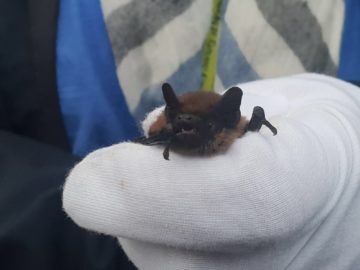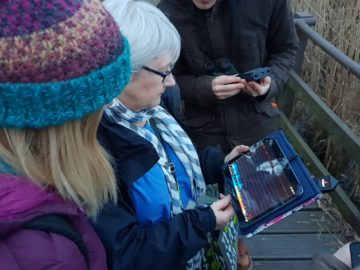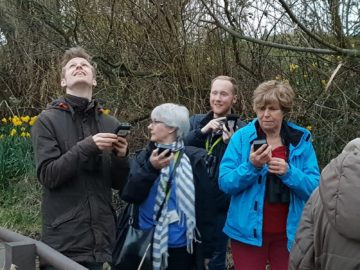This past Monday, guests were treated to an introductory talk on bat ecology and a bat walk to Newcastle’s Exhibition Park courtesy of NHSN Admin and Support Officer, and Northumberland Bat Group Chair, Hazel Makepeace.
 Meeting at the doors of the Great North Museum: Hancock just before dusk, the first of many surprises lay in store for participants as, upon arrival, NHSN staff located a grounded Common Pipistrelle in the museum grounds – a little underweight as a result of the prolonged Winter weather but otherwise unscathed. This provided visitors with an up-close and personal encounter with the species and, based on the beaming smiles of those present, will surely go down as an unexpected highlight of the night for many.
Meeting at the doors of the Great North Museum: Hancock just before dusk, the first of many surprises lay in store for participants as, upon arrival, NHSN staff located a grounded Common Pipistrelle in the museum grounds – a little underweight as a result of the prolonged Winter weather but otherwise unscathed. This provided visitors with an up-close and personal encounter with the species and, based on the beaming smiles of those present, will surely go down as an unexpected highlight of the night for many.
This initial encounter provided fitting background to Hazel’s talk which covered, in detail, all aspects of the bat’s life: from feeding behaviour and hibernation to breeding biology and habitat preference. The attention of the assembled crowd unwavering throughout until that is, in somewhat unpredictable fashion, a single bat flew over the heads of the observers – a good omen of things to come.
Heading into Exhibition Park, the scene was set for a wonderful evening: mild temperatures, little wind and the pleasant song of numerous thrushes gracing our ears as we headed for the lake. Our arrival here met, almost immediately, by the sight of two bats hawking for insects high above the outstretched limbs of a stand of lime. Numbers gradually increasing throughout our stay until, at long last, approximately ten bats hunted above the parks small lake – flying within inches of the crowd as we watched, and listened. Using various models of bat detector to tune into the high-pitched vocalisations of the Common and Soprano Pipistrelles above us. Perhaps more interesting still, visitors were also able to visualise the bats calls courtesy of some high-tech sonogram equipment brought along by Hazel – the rising and falling of the bars on the screen demonstrating, perfectly, the slight but distinct difference in pitch between species. As their name suggests, Soprano Pipistrelles have a somewhat higher call. Who would have thought, eh?
On a final, positive note, the bat found at the start of the evening is now doing fine in Hazel’s care and will be released soon. Hopefully with a much better chance of survival.
If you would like to attend similar NHSN events in the future, you can view our list of scheduled talks and excursions here: https://nhsn.org.uk/activities/talks-field-trips-events-activities/

